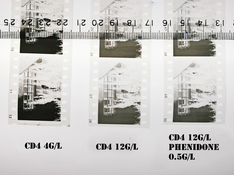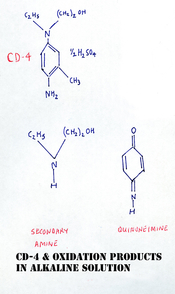Alan Johnson
Subscriber
- Joined
- Nov 16, 2004
- Messages
- 3,217
I have found that use of high concentrations of CD-4 reduces the contrast of microfilms [pic] and the contrast is further reduced by minimal agitation every 3 min.
In combination with reduction of contrast in scanner software this enables some microfilms to be shot at box speed.
The CD-4 oxidation products [pic] probably partially block the silver grain surfaces, their composition is discussed by Weissberger:
CD4-LC
Metol........................................1g
Sodium Sulfite anh...........30g
CD-4.......................................12g
Borax........................................4g
Water to...................................1L.....pH~8...............store in glass bottle under inert gas.
The developer is used with 5 inversions at start then 2 inversions every 3rd minute, adding 30% to the times given below, temperature correction according to the chart at Ilfordphoto.com.
Film 1 9m , 2 9.5 min, 3 9.9 min,4 10.5 min, 5 11 min,6 11.5 min, 7 12min, 812.7min, 9 13.2min, 10 14 min, all times for 20C. Reduce times if negatives too dense. Fix 2 min, wash 5min, Photoflo.
Examples:
Adox CMS20 II EI=20:
Spur Ultra R 800 EI=32:
In combination with reduction of contrast in scanner software this enables some microfilms to be shot at box speed.
The CD-4 oxidation products [pic] probably partially block the silver grain surfaces, their composition is discussed by Weissberger:
CD4-LC
Metol........................................1g
Sodium Sulfite anh...........30g
CD-4.......................................12g
Borax........................................4g
Water to...................................1L.....pH~8...............store in glass bottle under inert gas.
The developer is used with 5 inversions at start then 2 inversions every 3rd minute, adding 30% to the times given below, temperature correction according to the chart at Ilfordphoto.com.
Film 1 9m , 2 9.5 min, 3 9.9 min,4 10.5 min, 5 11 min,6 11.5 min, 7 12min, 812.7min, 9 13.2min, 10 14 min, all times for 20C. Reduce times if negatives too dense. Fix 2 min, wash 5min, Photoflo.
Examples:
Adox CMS20 II EI=20:
Spur Ultra R 800 EI=32:
Attachments
Last edited:















